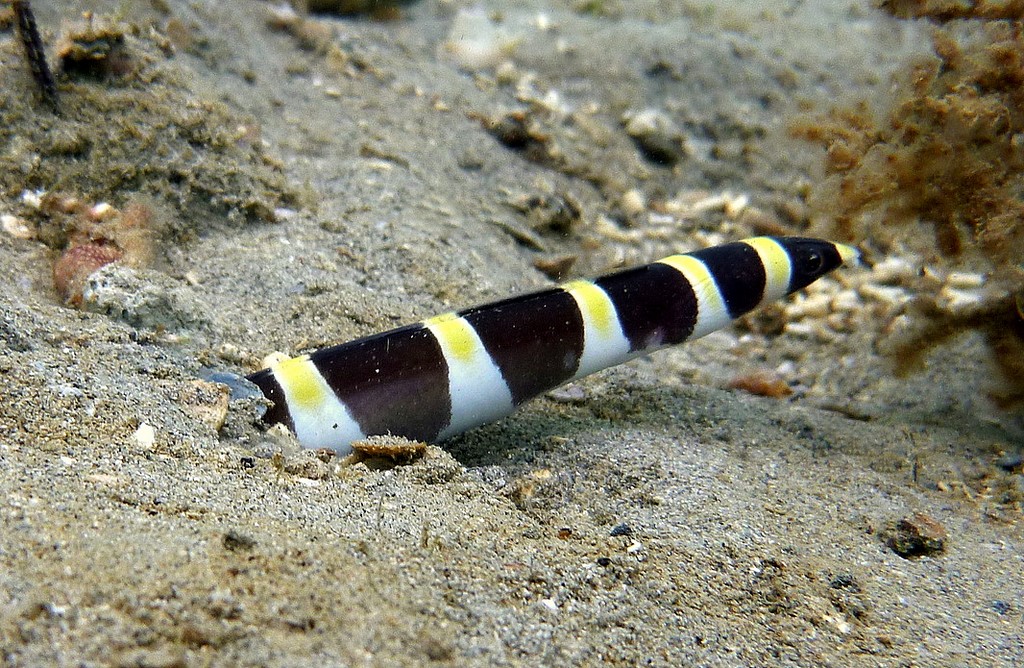LEIURANUS SEMICINCTUS - (LAY & BENNETT, 1839)
Picture courtesy of: Claire Goiran
Actinopterygii (Gigaclass) > Actinopteri (Class) > Teleostei (Subclass) > Elopomorpha (Superorder) > Anguilliformes (Order) > Congroidei (Suborder) > Ophichthidae (Family) > Ophichthinae (Subfamily) > Leiuranus (Genus)
Anguille-serpent à selles, Saddled snake eel, Culverin, Banded snake eel, Halfbanded snake-eel, Saddled snake-eel, Sattel-Schlangenaal, Halfband-slangpaling, Sora-umihebi, ソラウミヘビ, 半环平盖蛇鳗, 半环盖蛇鳗,
Synonymes
Leiuranus lacepedii (Bleeker, 1852)
Leiuranus phoenixensis (Schultz, 1943)
Liuranus semicinctus (Lay & Bennett, 1839)
Machaerenchelys phoenixensis (Schultz, 1943)
Machaerenchelys vanderbilti (Fowler, 1938)
Ophisurus semicinctus (Lay & Bennett, 1839)
Ophisurus vimineus (Richardson, 1845)
Sphagebranchus cinctus (Tanaka, 1908)
----------------------
Description
Vertebrae: 162-171. Head length: 11-15 in TL; Body depth: 33-70 in TL; Tail length: 1.9-2.1 in TL. Preanal length: 2.1-2.3 in TL; Vertebrae: 164-171; Snout pointed, mouth inferior, upper lip not fringed with cirri; Anterior nostrils lacking conspicuous leaf-like appendages; Eye relatively large, positioned above middle of gape; Intermaxilla with about five nearly recumbent, small canine teeth in ventral groove beneath snout; Remaining teeth in jaws small and uniserial; Vomer with 0-3 small teeth. Dorsal fin origin above or slightly posterior to gill opening; Pectoral fins reduced, about the size of the gill opening. Max. length: 66.0 cm TL. Depth range: 0 - 70 m, usually 0 - 10 m.
Color
Whitish to pale yellow with about 20-30 broad, black saddle-like bars along the body, width of saddles equal to or greater than width of pale interspaces; Only saddles on rear of tail extending to ventral midline.
Etymology
Leiuranus: from Greek, leîos = smooth, sleek + from greek urano-, ouraniskos = little sky-vault, the palate. Referring to toothless vomer.
semicinctus: from Latin prefix, sēmi- = half, partially + from Latin, cinctus = surrounded, encircled, having been surrounded. Referring to “fascia-like patches of darkbrown, which do not surround the body, but are interrupted on the under surface”.
Original description: Ophisurus semicinctus Lay & Bennett, 1839 - Type locality: Oahu, Hawaiian Islands, central Pacific.
Distribution
Indo-West Pacific: Eastern Cape and KwaZulu-Natal (South Africa), East Africa, Aldabra (Seychelles), Seychelles, Comoros, Madagascar and Mascarenes (La Réunion, Mauritius, Rodrigues), east to Hawaiian Islands (U.S.A.) and Pitcairn Group, north to southern Japan, south to Western Australia, Lord Howe Island (Australia) and New Caledonia.
Biology
Occurs in sandy areas and seagrass beds of both lagoon and seaward reefs. Uses its stiff pointed tail to rapidly burrow backwards into the sand when frightened. Benthic. Feeds on sand-dwelling fishes and crabs and prawns. Sometimes fully exposed when searching for prey. Rises to the surface to spawn. Once there, one or more males may seize a female by the back of the neck and remain attached for hours before spawning occurs.
Similar species
Leiuranus versicolor (Richardson, 1848) - Reported from New Caledonia - Link to the species (here).
Myrichthys colubrinus (Boddaert, 1781) - Reported from New Caledonia - Link to the species (here).
Last update: 30, March 2024
Actinopterygii (Gigaclass) > Actinopteri (Class) > Teleostei (Subclass) > Elopomorpha (Superorder) > Anguilliformes (Order) > Congroidei (Suborder) > Ophichthidae (Family) > Ophichthinae (Subfamily) > Leiuranus (Genus)
Anguille-serpent à selles, Saddled snake eel, Culverin, Banded snake eel, Halfbanded snake-eel, Saddled snake-eel, Sattel-Schlangenaal, Halfband-slangpaling, Sora-umihebi, ソラウミヘビ, 半环平盖蛇鳗, 半环盖蛇鳗,
Synonymes
Leiuranus lacepedii (Bleeker, 1852)
Leiuranus phoenixensis (Schultz, 1943)
Liuranus semicinctus (Lay & Bennett, 1839)
Machaerenchelys phoenixensis (Schultz, 1943)
Machaerenchelys vanderbilti (Fowler, 1938)
Ophisurus semicinctus (Lay & Bennett, 1839)
Ophisurus vimineus (Richardson, 1845)
Sphagebranchus cinctus (Tanaka, 1908)
----------------------
Description
Vertebrae: 162-171. Head length: 11-15 in TL; Body depth: 33-70 in TL; Tail length: 1.9-2.1 in TL. Preanal length: 2.1-2.3 in TL; Vertebrae: 164-171; Snout pointed, mouth inferior, upper lip not fringed with cirri; Anterior nostrils lacking conspicuous leaf-like appendages; Eye relatively large, positioned above middle of gape; Intermaxilla with about five nearly recumbent, small canine teeth in ventral groove beneath snout; Remaining teeth in jaws small and uniserial; Vomer with 0-3 small teeth. Dorsal fin origin above or slightly posterior to gill opening; Pectoral fins reduced, about the size of the gill opening. Max. length: 66.0 cm TL. Depth range: 0 - 70 m, usually 0 - 10 m.
Color
Whitish to pale yellow with about 20-30 broad, black saddle-like bars along the body, width of saddles equal to or greater than width of pale interspaces; Only saddles on rear of tail extending to ventral midline.
Etymology
Leiuranus: from Greek, leîos = smooth, sleek + from greek urano-, ouraniskos = little sky-vault, the palate. Referring to toothless vomer.
semicinctus: from Latin prefix, sēmi- = half, partially + from Latin, cinctus = surrounded, encircled, having been surrounded. Referring to “fascia-like patches of darkbrown, which do not surround the body, but are interrupted on the under surface”.
Original description: Ophisurus semicinctus Lay & Bennett, 1839 - Type locality: Oahu, Hawaiian Islands, central Pacific.
Distribution
Indo-West Pacific: Eastern Cape and KwaZulu-Natal (South Africa), East Africa, Aldabra (Seychelles), Seychelles, Comoros, Madagascar and Mascarenes (La Réunion, Mauritius, Rodrigues), east to Hawaiian Islands (U.S.A.) and Pitcairn Group, north to southern Japan, south to Western Australia, Lord Howe Island (Australia) and New Caledonia.
Biology
Occurs in sandy areas and seagrass beds of both lagoon and seaward reefs. Uses its stiff pointed tail to rapidly burrow backwards into the sand when frightened. Benthic. Feeds on sand-dwelling fishes and crabs and prawns. Sometimes fully exposed when searching for prey. Rises to the surface to spawn. Once there, one or more males may seize a female by the back of the neck and remain attached for hours before spawning occurs.
Similar species
Leiuranus versicolor (Richardson, 1848) - Reported from New Caledonia - Link to the species (here).
Myrichthys colubrinus (Boddaert, 1781) - Reported from New Caledonia - Link to the species (here).
Last update: 30, March 2024
